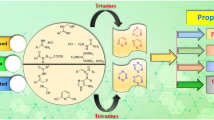Abstract
Bioactive 3-ferrocenylaniline [(η5-C5H4)2Fe{C6H5NH2}] has been successfully synthesized and characterized by means of various physico-analytical techniques such as FTIR and multinuclear (1H and 13C) NMR spectroscopy along with melting point and elemental analysis. The interaction of the 3-ferrocenylaniline with DNA has been investigated by spectroscopic and viscometric measurements. The interaction of compound with DNA is presumably occurring via hydrogen bonding. Viscosity measurement of the compound has proved to change in length and is regarded as the least ambiguous and the most critical test of binding model in solution. The antibacterial activity was carried out using Gram-positive bacteria (Staphylococcus aureus, Micrococcus luteus) and Gram-negative bacteria (Escherichia coli, Klebsiella pneumoniae) and found to be selective and effective against Gram-positive bacteria. In vitro antifungal activity was determined against the fungal species (Aspergillus niger and Aspergillus flavus) and demonstrated significant activity.
Graphical Abstract
Compound 1 was synthesized from ferrocene and 3-nitroaniline in the presence of sodium nitrite/hydrochloric acid and the resulting product was reduced to 3-ferrocenyl aniline. The compound was characterized by IR, multinuclear (1H and 13C) NMR, and elemental analysis. DNA interaction studies were examined by spectroscopic and viscosity measurements. Antibacterial and antifungal activities are also tested.




Similar content being viewed by others
References
Altaf AA, Khan N, Badshah A, Lal B, Ullah S, Anwar S, Subhan M (2011) Improved synthesis of ferrocenyl aniline. J Chem Soc Pak 33:691–693
Anthony JP (1985) Metallo-organic chemistry. Wiley, Brisbane
Araki S, Nakai T, Hizume K, Takeyasu K, Yoshikawa K (2006) Hydrodynamic radius of circular DNA is larger than that of linear DNA. Chem Phys Lett 418:255–259
Armarego WLF, Perrin DD (2000) Purification of laboratory chemicals, 4th edn. Butterworth–Heinemann, Oxford
Aslanoglu M, Ayne G (2004) Voltammetric studies of the interaction of quinacrine with DNA. Anal Bioanal Chem 380:658–663
Aslanoglu M, Oge N (2005) Voltammetric, UV absorption and viscometric studies of the interaction of norepinephrine with DNA. Turk J Chem 29:477–485
Babkina SS, Ulakhovich NA (2005) Complexing of heavy metals with DNA and new bioaffinity method of their determination based on amperometric DNA-based biosensor. Anal Chem 77:5678–5685
Brett CMA, Brett AMO (1993) Electrochemistry: principles, methods and applications. Oxford Science University Publications, Oxford
Bruijnicnx PCA, Sadler PJ (2008) New trends for metal complexes with anticancer activity. Curr Opin Chem Biol 12:197–206
Carter MT, Rodriguez M, Bard AJ (1989) Voltammetric studies of the interaction of metal chelates with DNA. 2. Tris–chelated complexes of cobalt(III) and iron(II) with 1,10-phenanthroline and 2,2′-bipyridine. J Am Chem Soc 111:8901–8911
Chao H, Mei W, Huang Q, Ji L (2002) DNA binding studies of ruthenium(II) complexes containing asymmetric tridentate ligands. J Inorg Biochem 92:165–170
Ducani C, Leczkowska A, Hodges NJ, Hannon MJ (2010) Noncovalent DNA-binding metallo-supramolecular cylinders prevent DNA transactions in vitro. Angew Chem Int Ed Engl 49:8942–8945
Guo Y, Chao J, Pan J (2007) Study on the interaction of 5-pyridine-10,15,20-tris-(p-chlorophenyl)porphyrin with cyclodextrins and DNA by spectroscopy. Spectrochim Acta A Mol Biomol Spectrosc 68:231–236
Ilkhani H, Ganjali MR, Arvand M, Norouz P (2010) Electrochemical and spectroscopic study of samarium ion interaction with DNA in different pHs. Int J Electrochem Sci 5:168–176
Lah J, Bezan M, Vesnaver G (2001) Thermodynamics of berenil binding to poly [d(AT)] poly [d(AT)] and poly [d(A)] poly [d(T)] duplexes. Acta Chim Slov 48:289–308
Liu J, Zhang T, Lu T, Qu L, Zhou H, Zhang Q, Ji L (2002) DNA-binding and cleavage studies of macrocyclic copper(II) complexes. J Inorg Biochem 91:269–276
Reddy BSP, Sondhi SM, Lown JW (1999) Synthetic DNA minor groove-binding drugs. Pharmacol Ther 84:1–111
Reynisson J, Schuster GB, Howerton SB, Williams LD, Barnett RN, Cleveland CL, Landman U, Harrit N, Chaires JB (2003) Intercalation of trioxatriangulenium ion in DNA: binding, electron transfer, x-ray crystallography, and electronic structure. J Am Chem Soc 125:2072–2083
Saeed A, Shaheen U, Hameed A, Naqvi SZH (2009) Synthesis, characterization and antimicrobial activity of some new 1-(fluorobenzoyl)-3-(fluorophenyl)thioureas. J Fluor Chem 130:1028–1034
Senthil S, Kannan P (2001) Ferrocene-based organophosphorus liquid–crystalline polymers: synthesis and characterization. J Polym Sci A Polym Chem 39:2396–2403
Shah A, Khan AM, Qureshi R, Ansari FL, Nazar MF, Shah SS (2008a) Redox behavior of anticancer chalcone on a glassy carbon electrode and evaluation of its interaction parameters with DNA. Int J Mol Sci 9:1424–1434
Shah A, Qureshi R, Janjua NK, Haque S, Ahmad S (2008b) Electrochemical and spectroscopic investigations of protonated ferrocene–DNA intercalation. Anal Sci 24:1437–1441
Song Y, Kang J, Wang Z, Lu X, Gao J, Wang L (2002) Study on the interaction between CuL and Morin with DNA. J Inorg Biochem 91:470–474
Vaidyanathan VG, Nair BU (2003) Synthesis, characterization and binding studies of chromium(III) complex containing an intercalating ligand with DNA. J Inorg Biochem 95:334–342
Verma VK, Asatkar AK, Jain TA, Tripathi SK, Singh R, Hitchcock PB, Nigam S, Gupta SK (2009) Synthesis, structure and DNA binding studies of a mononuclear copper(II) complexes with mixed donor macroacyclic ligand, 2,6-bis({N-2&3-(phenylselenato)alkyl}benzmidoyl)-4-methylphenol. Polyhedron 28:2591–2598
Zhang G, Hu X, Pan J (2010) Spectroscopic studies of the interaction between pirimicarb and calf thymus DNA. Spectrochim Acta A Mol Biomol Spectrosc 78:687–694
Zhao GC, Zhu JJ, Zhang JJ, Chen HY (1999) Voltammetric studies of the interaction of methylene blue with DNA by means of b-cyclodextrin. Anal Chim Acta 394:337–344
Acknowledgments
Authors highly acknowledge the Department of Microbiology, Quaid-I-Azam University and Higher Education Commission Islamabad, Pakistan, for their support.
Author information
Authors and Affiliations
Corresponding author
Rights and permissions
About this article
Cite this article
Ali, S., Badshah, A., Ataf, A.A. et al. Synthesis of 3-ferrocenylaniline: DNA interaction, antibacterial, and antifungal activity. Med Chem Res 22, 3154–3159 (2013). https://doi.org/10.1007/s00044-012-0311-8
Received:
Accepted:
Published:
Issue Date:
DOI: https://doi.org/10.1007/s00044-012-0311-8




